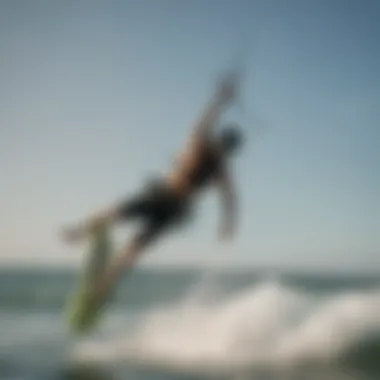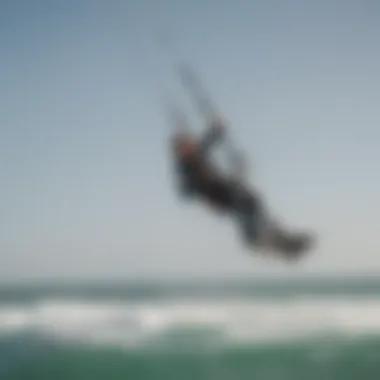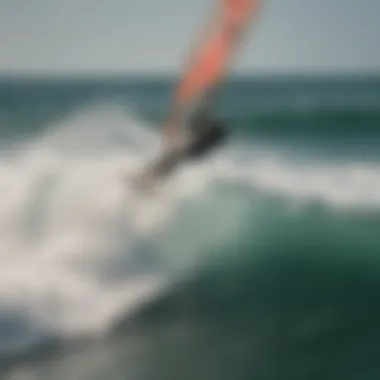Master the Backrolling Technique in Kitesurfing and Kiteboarding


Equipment Reviews
In the dynamic world of kitesurfing and kiteboarding, having the right equipment is paramount to success and safety out on the water. Kites play a pivotal role in these sports, coming in various shapes, sizes, and materials tailored to different riding styles and wind conditions. From bow kites to delta kites, each design offers a unique set of benefits and performance characteristics. Leading kite brands like Cabrinha, Naish, and Slingshot dominate the market, continually pushing the boundaries of innovation and quality.
When it comes to boards, kiteboarders have a range of options to consider, including twintips and directional boards. Twintips are versatile and ideal for freestyle riding, while directional boards excel in wave riding conditions. The construction of these boards, whether using wood, foam, or carbon fiber, directly impacts their durability and responsiveness on the water. Understanding the nuances of each board type is essential for riders to maximize their enjoyment and performance.
For accessories, kiteboarders rely on a suite of essential gear to enhance their experience and safety. Harnesses provide riders with control and support during maneuvers, while specialized lines ensure strong and reliable connections between the kite and the rider. A reliable pump is crucial for inflating kites quickly and efficiently, saving time and energy for more time on the water. Safety gear like helmets, impact vests, and safety leashes are non-negotiable items that offer protection and peace of mind while pushing the limits in these adrenaline-fueled sports.
Introduction
Kitesurfing and kiteboarding enthusiasts embarking on the quest to master the art of backrolling are on a journey to elevate their skills and experience on the water. This article delves deep into the intricacies of backrolling, offering insights and techniques to enthusiasts of all levels, from novices to experts. Understanding the nuances of backrolling is fundamental to enhancing one's performance and style on the board, making it a pivotal skill in the repertoire of any serious rider.
Understanding the Backroll
Definition and Purpose of Backrolling
The essence of backrolling lies in the aerial maneuver that involves rotating backwards while airborne, adding a dynamic flair to kitesurfing and kiteboarding. This skill contributes significantly to the overall fluidity and creativity of a rider's performance. The key characteristic of backrolling is its seamless integration of technique and style, offering riders a visually stunning and technically challenging move to incorporate into their sessions. The uniqueness of backrolling lies in its ability to showcase a rider's control and finesse in executing complex maneuvers, making it a popular choice for those looking to showcase their skills on the water.
Historical Significance in Kitesurfing and Kiteboarding
The historical roots of backrolling trace back to the early days of kitesurfing and kiteboarding, where riders sought ways to push the boundaries of the sport. This maneuver's emergence marked a shift towards more progressive and innovative riding styles, shaping the evolution of modern kitesurfing and kiteboarding. The significance of backrolling lies in its pioneering role in expanding the trick vocabulary of riders, introducing a new level of creativity and excitement to the sport. While its advantages are undeniable, mastering the intricacies of this move requires dedication and practice, underscoring its importance in the landscape of kitesurfing and kiteboarding.
Benefits of Learning Backrolls
Enhanced Style and Aesthetic Appeal
Embracing backrolls enhances a rider's overall style, infusing their performance with a heightened level of creativity and flair. The key characteristic of enhanced style and aesthetic appeal lies in the visual impact it adds to a rider's repertoire, setting them apart as a skilled and versatile practitioner. This choice to incorporate backrolls not only elevates the artistic value of a rider's maneuvers but also demonstrates their commitment to continual improvement and innovation.


Improvement in Overall Riding Technique
The practice of backrolling contributes significantly to enhancing a rider's overall riding technique, refining their control and agility on the board. The key characteristic of this improvement lies in the development of core skills such as balance, coordination, and spatial awareness, crucial for maneuvering through diverse water conditions efficiently. By focusing on backrolling, riders can progress steadily in their mastery of the sport, consolidating their foundation and honing their abilities for more advanced tricks.
Expanding Trick Repertoire
Backrolling serves as a gateway to expanding a rider's trick repertoire, opening up a world of possibilities for creative expression and technical skill development. The key feature of this expansion is the limitless potential it offers in terms of exploring new tricks and combinations, fueling a rider's passion for experimentation and growth. By diversifying their trick portfolio with backrolls, riders can challenge themselves to achieve greater heights of performance and proficiency, unlocking new horizons in their kitesurfing and kiteboarding journey.
Prerequisites for Backrolling
Proficiency in Basic Kitesurfing or Kiteboarding Skills
Mastering backrolls requires a solid foundation in basic kitesurfing or kiteboarding skills, encompassing essential techniques and maneuvers fundamental to riding. The key characteristic of proficiency in these skills lies in the rider's ability to maintain control and stability on the board, setting the stage for more advanced maneuvers like backrolls. Understanding the basic principles of riding forms the cornerstone of successful backrolling, enabling riders to progress smoothly in their skill development journey.
Understanding Wind Conditions and Power Zones
A crucial aspect of backrolling revolves around a deep understanding of wind conditions and power zones, essential for executing the maneuver with precision and finesse. The key characteristic of comprehending wind conditions lies in leveraging nature's forces to enhance the execution of backrolls, harnessing the wind's power to propel and sustain the rider's movements. By mastering the intricacies of wind dynamics and power zones, riders can optimize their backrolling performance, adapting fluidly to varying conditions and maximizing their ride potential.
Technique Breakdown
Technique Breakdown plays a pivotal role in the realm of kitesurfing and kiteboarding. It acts as the foundational framework upon which the entirety of one's skills and maneuvers is constructed. Understanding the intricacies of Technique Breakdown is crucial for enthusiasts looking to elevate their performance on the water. In this comprehensive guide on backrolling, the Technique Breakdown section delves deep into the nuances of each phase, from initial setup to execution and landing. By comprehensively dissecting the technique, readers will gain a holistic understanding of the backrolling process, equipping them with the knowledge to master this skill effectively.
Initial Setup and Approach
Positioning on the Board and Kite When it comes to Positioning on the Board and Kite, precision is key. A slight deviation in positioning can significantly impact the success of a backroll maneuver. This section highlights the importance of aligning oneself correctly on the board and manipulating the kite to optimize takeoff angles. Emphasizing the role of balance and orientation, mastering the art of positioning can spell the difference between a flawless backroll and a failed attempt. Understanding the intricacies of ideal positioning sets the stage for a smooth and controlled execution, making it a fundamental aspect of backrolling expertise.
Angle of Takeoff Discussing the Angle of Takeoff sheds light on a critical component in the backrolling equation. The angle at which a rider initiates their maneuver directly affects the trajectory and rotation of the backroll. By exploring the optimal angles for takeoff and the adjustments required based on wind conditions, riders can enhance the fluidity of their rotations. The Angle of Takeoff section outlines the subtleties involved in achieving the perfect launch, offering insights into adjusting angles for varying styles and proficiency levels. Mastering this element sets the stage for a seamless and controlled execution of the backroll maneuver.
Execution of the Backroll


Initiating Rotation with Kite Control Initiating Rotation with Kite Control is a make-or-break phase in the backroll sequence. This aspect focuses on the precise manipulation of the kite to induce rotational movement while maintaining stability. By understanding how kite control impacts rotation speed and amplitude, riders can fine-tune their maneuvers for optimal performance. The section elaborates on the nuances of syncing kite movements with body positioning, underscoring the significance of timing and coordination. Exploring strategies for generating rotational force through kite control provides riders with a comprehensive roadmap to executing seamless backrolls with finesse.
Body Positioning and Momentum Comprehending the dynamics of Body Positioning and Momentum is essential for a successful backroll execution. This facet underscores the significance of body alignment, weight distribution, and momentum management during the rotation phase. By optimizing body posture and leveraging momentum effectively, riders can enhance the aesthetics and efficiency of their backroll maneuvers. The section delves into strategies for maximizing rotational momentum, maintaining core stability, and achieving aerial control through precise body adjustments. By mastering the art of body positioning and momentum control, riders can elevate the quality of their backroll performances significantly.
Landing and Recovery
Spotting the Landing Zone Spotting the Landing Zone is a critical element in ensuring a safe and controlled descent post-backroll. This segment focuses on the visual acuity and spatial awareness required to pinpoint an optimal landing spot amidst dynamic water conditions. By honing the skill of identifying landing zones beforehand and making real-time adjustments during descent, riders can minimize impact forces and facilitate a smooth landing transition. The Spotting the Landing Zone section elucidates the strategic considerations involved in selecting landing areas, emphasizing safety and precision in backroll landings.
Absorption of Impact Addressing the Absorption of Impact emphasizes the techniques and strategies involved in cushioning the landing impact post-backroll. Efficiently absorbing impact forces plays a crucial role in preventing injuries and maintaining control during landing sequences. By mastering the art of impact absorption through varied landing approaches and posture adjustments, riders can enhance their resilience and reduce the physical toll of high-impact maneuvers. This section dissects the principles of impact distribution, joint flexion, and weight dispersion, offering riders a comprehensive guide to safe and controlled landings. Mastering the skill of impact absorption is instrumental in advancing one's backroll proficiency while prioritizing rider safety and performance longevity.
Advanced Tips and Common Mistakes
In the realm of kitesurfing and kiteboarding, mastery of backrolling hinges significantly on executing advanced techniques and steering clear of common blunders. Devoting attention to this section proves pivotal for riders of all levels, ensuring a refined skillset and averted pitfalls. Understanding the intricate dynamics intertwined with backrolling enables enthusiasts to elevate their performance and safety.
Delving into the nuances of fine-tuning your backroll is imperative for honing expertise in kitesurfing and kiteboarding. The subdivision 'Fine-Tuning Your Backroll' serves as a beacon for enthusiasts looking to refine their rotation technique. By exploring the subtleties of rotation refinement, riders can elevate their fluidity and precision while executing backrolls. This facet stands as a linchpin for seamless execution and advanced maneuvers.
- Refinement of Rotation Technique: When dissecting the essence of rotation refinement within the context of backrolling, a profound emphasis is placed on honing the intricate mechanics of rotation. Perfecting this aspect bolsters overall performance and style, distinguishing proficient riders from amateurs. The finesse in rotation technique amplifies the grace and fluidity of backrolling, underscoring its indispensability in the skill set of any serious kitesurfer or kiteboarder.
- Achieving Smooth Transitions: Transitioning seamlessly between maneuvers is tantamount to achieving mastery in kitesurfing and kiteboarding. 'Achieving Smooth Transitions' encapsulates the essence of fluidity and poise during ride execution. By emphasizing the importance of seamless transitions, riders can mitigate disruptions in their flow, culminating in a more polished and professional riding experience.
Prevention of common pitfalls in backrolling demands vigilance and a keen understanding of potential adversities. Mitigating these risks safeguards riders from injuries and setbacks, ensuring a progressive and safe kitesurfing or kiteboarding journey. A meticulous examination of potential pitfalls instills riders with the foresight necessary to navigate challenges with agility and adeptness.
- Overrotation and Underrotation: Excessive or inadequate rotation poses a significant threat to the seamless execution of backrolls. 'Overrotation and Underrotation' zeroes in on the delicate balance required for optimal performance. Identifying and rectifying these issues fortifies the foundation of backrolling technique, enhancing precision and minimizing errors inherent in rotation maneuvers.
- Loss of Control in Landing: Maintaining control throughout the landing phase is pivotal to a successful backroll. 'Loss of Control in Landing' sheds light on the critical component of landing proficiency. Understanding the nuances of landing control empowers riders to secure a smooth and stable conclusion to their maneuvers, significantly reducing the risk of falls and injuries
Practice Drills and Progression
Practice drills and progression play a pivotal role in the journey of mastering backrolling in kitesurfing and kiteboarding. These drills not only enhance muscle memory but also aid in refining technique and boosting confidence on the water. In the realm of extreme water sports, such meticulous preparation is paramount to ensuring smooth execution and mitigating risks. Riders at all levels benefit from incorporating structured practice sessions into their routine.
Drills for Backroll Mastery
Simulated Rotations on Land


Simulated rotations on land are a fundamental aspect of backroll mastery, offering riders the opportunity to dissect and perfect their movements in a controlled environment. This technique helps riders understand the mechanics of the backroll without the complexities of water, allowing them to focus solely on the rotational aspect. By breaking down each step on land, individuals can refine their coordination and timing, ultimately translating these skills to the water effortlessly.
Slow Motion Practice in Shallow Water
Slow-motion practice in shallow water serves as a bridge between on-land simulations and full-speed maneuvers on the water. This method enables riders to feel the resistance of the water while still providing a safe environment for practice. By executing maneuvers at a reduced speed, athletes can pay close attention to their form, posture, and alignment, ironing out any imperfections before ramping up the intensity. It cultivates a sense of control and precision, fostering a gradual but steady improvement in technique.
Gradual Progression to Unhooked Backrolls
Developing Confidence for Unhooked Maneuvers
Developing confidence for unhooked maneuvers marks a significant milestone in an athlete's progression towards mastering unhooked backrolls. This stage emphasizes building trust in one's abilities and equipment, allowing riders to push beyond their comfort zones while maintaining composure. Through a structured approach focusing on gradual skill enhancement, individuals can conquer any lingering doubts and embrace the thrill of unhooked maneuvers with poise and assurance.
Transitioning from Hooked to Unhooked
Transitioning from hooked to unhooked maneuvers signifies a leap in a rider's technical prowess, requiring a delicate balance of skill and boldness. This shift empowers athletes to explore new horizons in their riding style, unlocking a realm of innovative tricks and maneuvers. By understanding the nuances of this transition, riders can seamlessly evolve their skill set, opening doors to a world of endless possibilities on the water.
Safety Considerations and Conclusion
Safety considerations and the conclusion are integral aspects of any kitesurfing or kiteboarding activity. Prioritizing safety ensures an enjoyable and incident-free experience on the water. Rigorous safety measures not only protect the rider but also those around them. Understanding the significance of safety considerations can prevent accidents and injuries, fostering a responsible kitesurfing community. Additionally, the conclusion is where key takeaways and final thoughts are summarized, offering a reflective moment on the backrolling journey. Stay tuned for valuable insights on how to ensure safety while enjoying the thrill of backrolling.
Safety Precautions for Backrolling
When it comes to backrolling, cautious preparation is key to minimizing risks and maximizing enjoyment. An essential safety measure is assessing wind and weather conditions before undertaking any backroll maneuver. This assessment allows riders to gauge the feasibility of performing the skill under current conditions, avoiding potential hazards. Another crucial aspect is the importance of body drag recovery. Understanding how to efficiently recover using body drag techniques can prevent being stranded in challenging circumstances, ensuring a swift return to a safe position. Incorporating these safety precautions into backrolling practices enhances the overall experience and promotes responsible kitesurfing practices.
Assessment of Wind and Weather Conditions
One of the critical aspects of kitesurfing safety is evaluating wind and weather conditions before engaging in any maneuvers. Assessing these conditions is essential for determining the stability and predictability of the wind, ensuring optimal performance during backrolls. By considering wind direction, speed, and potential gusts, riders can make informed decisions about when to attempt backrolling tricks. Being aware of weather changes and their impact on kiteboarding conditions is paramount for preventing accidents and achieving a successful backroll session.
Importance of Bode Darg Recovery
Body drag recovery plays a vital role in ensuring a safe exit strategy during kitesurfing sessions, including backrolls. Mastery of body drag techniques enables riders to navigate back to their board efficiently and swiftly after a fall, maintaining control and preventing drift towards hazardous areas. Understanding the importance of body drag recovery not only enhances safety but also instills confidence in riders to continue pushing their skills without apprehension, contributing to an enjoyable and secure kitesurfing experience.
Final Thoughts on Backrolling Mastery
As riders embark on the journey of mastering backrolls, embracing the learning process becomes fundamental. This involves accepting challenges, learning from mistakes, and persistently striving for improvement. Embracing the learning process fosters growth and skill development, leading to proficiency in executing flawless backrolls. Additionally, persistence and patience are key virtues in skill development. Mastering backrolls requires dedication and resilience in overcoming setbacks, ultimately culminating in a rewarding sense of achievement. By cultivating persistence and patience, kitesurfers can refine their skills and technique, unlocking a world of possibilities on the water.







